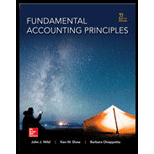
Concept Introduction:
1) Assets– It means what is owned by the business. The assets may be fixed assets or current assets. The current assets are those which can be easily converted into cash. All assets other than current assets are fixed assets. The fixed assets increase the earning capacity of the business.
2) Liability– It means what the business owes to the outside world. These are the claims against the assets of the company. The liabilities are of two types – long term liabilities and current liabilities. The current liabilities are those which are to be repaid within one year. The long term liabilities are those which are more than a year.
3) Equity– It means owner equity, which may be in form of share capital,
4) Net Assets – It means excess of total assets over liabilities.
Requirement -1- To define:
Assets, liabilities, Equity and net assets
Want to see the full answer?
Check out a sample textbook solution
Chapter 2 Solutions
Fundamental Accounting Principles -Hardcover
- A retail company purchased new display fixtures for $28,000. Old store equipment was sold for $2,500. A marketable security investment was sold for $45,000. Treasury stock was repurchased for $18,000, and dividends were paid to shareholders in the amount of $30,000. The company issued new bonds resulting in proceeds of $75,000. Calculate the net cash flow from investing activities.arrow_forwardI am trying to find the accurate solution to this financial accounting problem with appropriate explanations.arrow_forwardexplain properly all the answer for General accounting question Please given fastarrow_forward
- Nonearrow_forwardA manufacturing company uses the weighted-average method for inventory costing. At the end of the period, 20,500 units were in the ending Work-in-Process inventory and are 100% complete for materials and 68% complete for conversion. The equivalent costs per unit are materials $3.10 and conversion $2.45. Compute the cost that would be assigned to the ending Work-in-Process inventory for the period.arrow_forwardWhat is bayshore electronic net income? Financial accountingarrow_forward
- At the end of the first year, ClearStream Supplies had net accounts receivable of $54,000, and at the end of the second year, the company had net accounts receivable of $60,000. If the company's net sales revenue during the second year was $720,000, what was the receivables turnover ratio for the second year? a) 12.86 b) 13.85 c) 11.48 d) 6.38arrow_forwardHello tutor please given General accounting question answer do fast and properly explain all answerarrow_forwardPlease provide the answer to this general accounting question using the right approach.arrow_forward
- Dexter Equipment Co. had: • Net sales of $150,000 • Total assets of $100,000 • Year-end receivables of $18,000 . Inventory of $27,000 The company uses a 365-day year for calculations. What is Dexter's total asset turnover ratio? a) 1.25 b) 1.50 c) 1.33 d) 1.75 e) 1.85arrow_forwardGeneral accountingarrow_forwardKelton Corp. completed its first year of operations with 1,200 units of inventory remaining on hand. The variable and fixed manufacturing costs per unit were $85 and $25, respectively. If Kelton uses absorption costing rather than variable (direct) costing, the result would be a higher pretax income of:arrow_forward

 AccountingAccountingISBN:9781337272094Author:WARREN, Carl S., Reeve, James M., Duchac, Jonathan E.Publisher:Cengage Learning,
AccountingAccountingISBN:9781337272094Author:WARREN, Carl S., Reeve, James M., Duchac, Jonathan E.Publisher:Cengage Learning, Accounting Information SystemsAccountingISBN:9781337619202Author:Hall, James A.Publisher:Cengage Learning,
Accounting Information SystemsAccountingISBN:9781337619202Author:Hall, James A.Publisher:Cengage Learning, Horngren's Cost Accounting: A Managerial Emphasis...AccountingISBN:9780134475585Author:Srikant M. Datar, Madhav V. RajanPublisher:PEARSON
Horngren's Cost Accounting: A Managerial Emphasis...AccountingISBN:9780134475585Author:Srikant M. Datar, Madhav V. RajanPublisher:PEARSON Intermediate AccountingAccountingISBN:9781259722660Author:J. David Spiceland, Mark W. Nelson, Wayne M ThomasPublisher:McGraw-Hill Education
Intermediate AccountingAccountingISBN:9781259722660Author:J. David Spiceland, Mark W. Nelson, Wayne M ThomasPublisher:McGraw-Hill Education Financial and Managerial AccountingAccountingISBN:9781259726705Author:John J Wild, Ken W. Shaw, Barbara Chiappetta Fundamental Accounting PrinciplesPublisher:McGraw-Hill Education
Financial and Managerial AccountingAccountingISBN:9781259726705Author:John J Wild, Ken W. Shaw, Barbara Chiappetta Fundamental Accounting PrinciplesPublisher:McGraw-Hill Education





